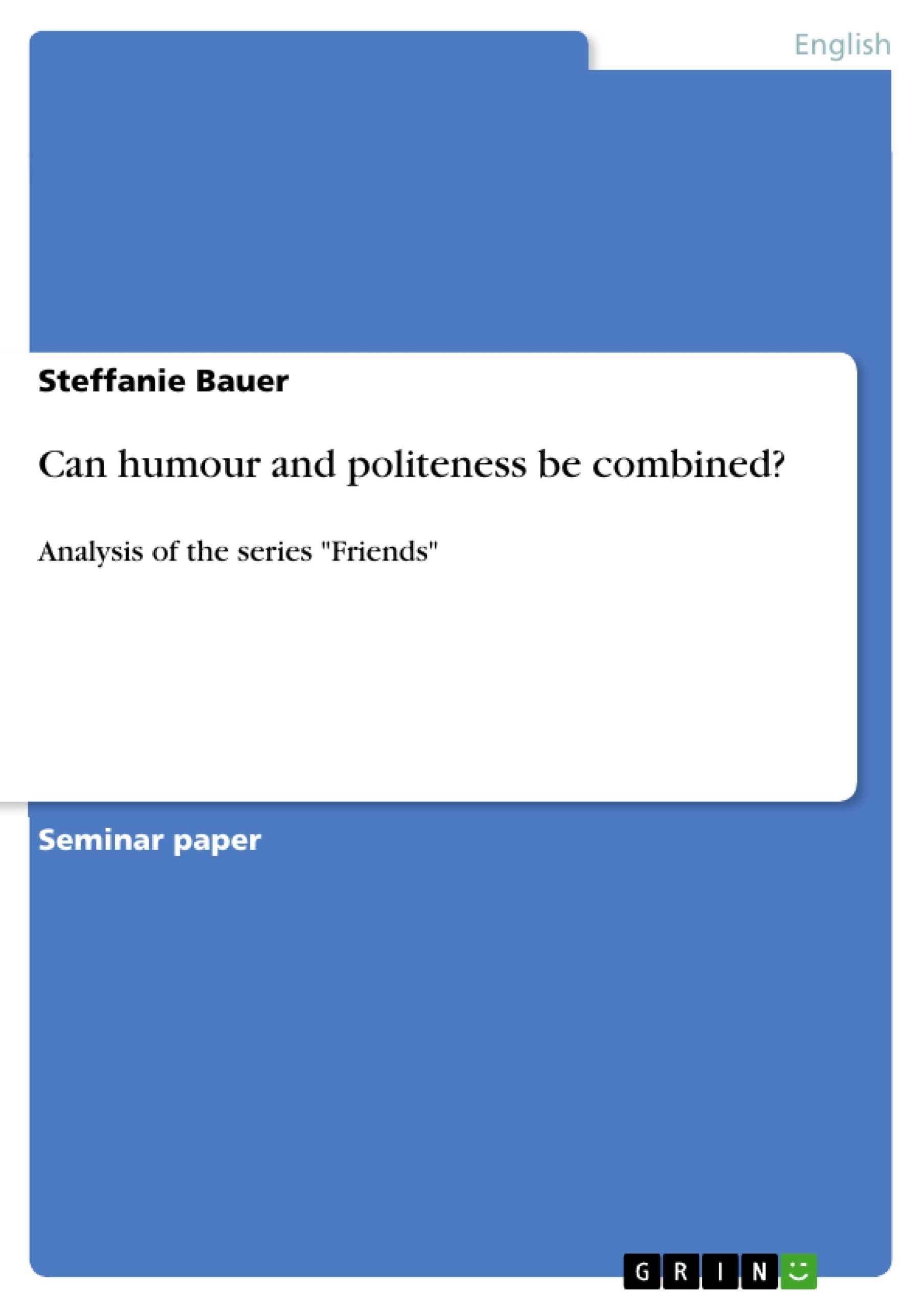Introduction
This paper deals with an analysis of one episode of the American comedy series Friends and the question whether the constructed conversation used there can be regarded as polite or not. Since this series is very comic, I will look at how politeness and comedy can be combined.
Concerning the notion of politeness, I will mainly stick to the theories of Brown and Levinson and Goffman, give brief summaries of their theories and discuss whether the characters in Friends violate the rules mentioned there in order to gain laughter from the audience.
I have chosen one single episode and will look deeply at several smaller parts of it in order to answer the question if humour can be used with polite behaviour or if they are not able to coexist. My thesis is that, if you are strict in keeping the rules, is not possible to be polite and funny at the same time because funny utterances can only occur in cases of violation of politeness rules.
I will not give a film analysis in this paper. I took the script of this episode and watched it in order to see where laughter is supposed to come, that means to see which phrases are supposed to be funny. These passages are marked in the script (which can be found in the appendix) by an asterisk.
Inhaltsverzeichnis (Table of Contents)
- Introduction
- Can humour and politeness be combined?
- The theories of Goffman and Brown/Levinson
- Goffman and the notion of face
- Brown/Levinson and the FTAs
- Some information on the series
- The analysed episode
- Comic elements in the episode
- Insulting causes laughter
- Lying causes laughter
- Irony causes laughter
- Interruption causes laughter
- A comparison to everyday conversation
- Conclusion
Zielsetzung und Themenschwerpunkte (Objectives and Key Themes)
This paper analyzes a single episode of the American comedy series "Friends" to investigate the relationship between humor and politeness in constructed conversations. It examines whether the interactions in the episode can be considered polite, focusing on the theories of Brown and Levinson and Goffman. The paper aims to determine if humor can be used in conjunction with polite behavior, or if they are inherently incompatible.
- The relationship between humor and politeness in conversation
- The theories of Brown and Levinson and Goffman regarding politeness and face
- The use of face-threatening acts (FTAs) in humor
- The role of running gags in generating humor
- The impact of cultural norms and expectations on humor and politeness
Zusammenfassung der Kapitel (Chapter Summaries)
- Introduction: Introduces the topic of humor and politeness in the context of the TV series "Friends," outlining the paper's scope and research question. It presents the main theoretical framework based on the works of Brown and Levinson and Goffman.
- Can humour and politeness be combined?: Explores the theories of Goffman and Brown/Levinson regarding face and politeness, summarizing their key concepts and analyzing how they apply to the chosen episode of "Friends." It examines the notion of face-threatening acts (FTAs) and their potential for humorous effect.
- The theories of Goffman and Brown/Levinson: Provides a more detailed explanation of the theoretical framework, focusing on Goffman's notion of face and Brown/Levinson's framework for understanding FTAs. It discusses the different strategies for managing FTAs and their implications for politeness and humor.
- Some information on the series: Offers background information about the American sitcom "Friends," including its popularity, duration, and main characters. It describes the setting and general themes of the series.
- The analysed episode: Provides a synopsis of the chosen episode, "The one after Joey and Rachel kiss," focusing on the characters' relationships and the episode's overall narrative.
- Comic elements in the episode: Examines specific comedic elements within the episode, such as running gags, insults, lying, irony, and interruptions, and analyzes how they contribute to the overall humor of the episode. It discusses the interplay between these comedic elements and the principles of politeness.
Schlüsselwörter (Keywords)
This paper focuses on the concepts of humor, politeness, face-threatening acts (FTAs), and face as defined by Goffman and Brown/Levinson. It uses the American sitcom "Friends" as a case study to analyze the relationship between these concepts within the context of constructed conversation. Key themes include the role of social norms, comedic strategies, and the interplay between politeness and humor in generating laughter.
- Citation du texte
- Steffanie Bauer (Auteur), 2007, Can humour and politeness be combined?, Munich, GRIN Verlag, https://www.grin.com/document/154410



